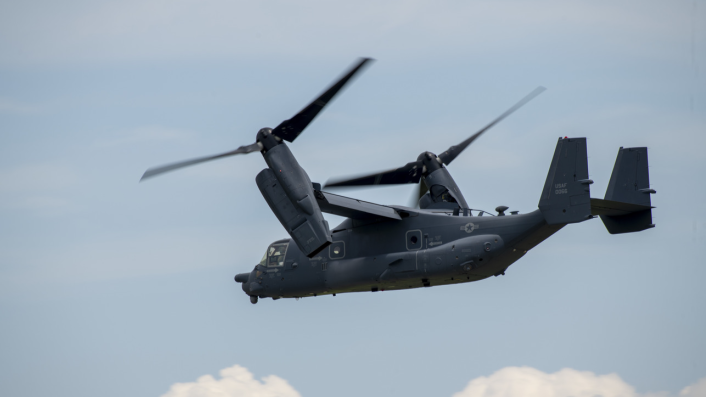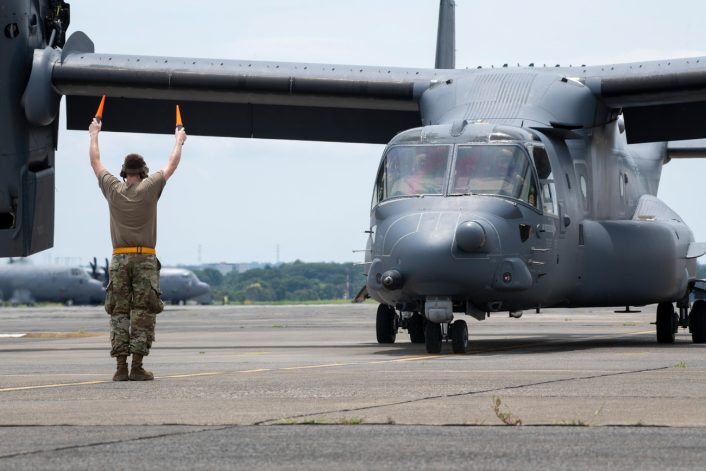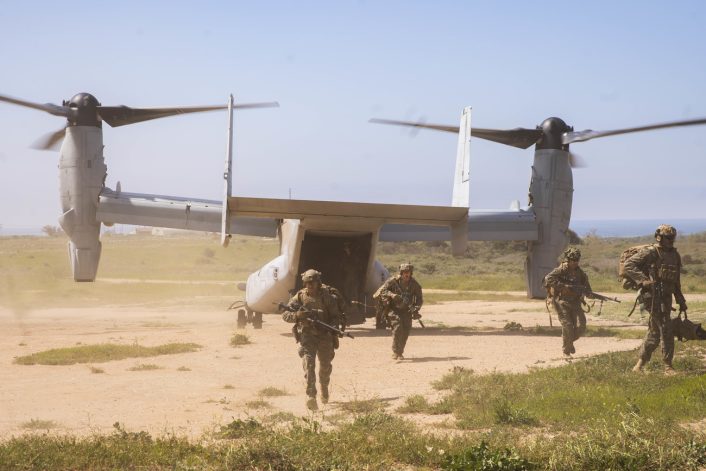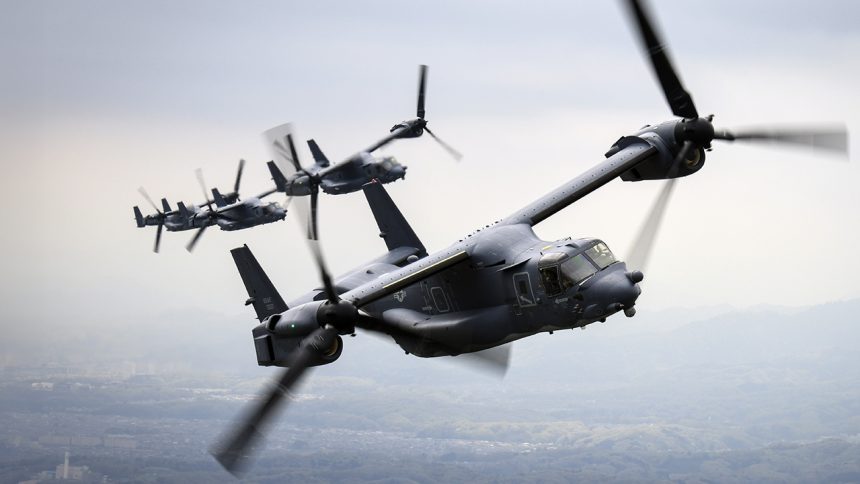The decision to resume CV-22 Osprey flight operations at Yokota Air Base, Japan, is based on a meticulous, data-driven approach, complemented by rigorous simulator training sessions for the crews.
Nearly a month after the US military leadership announced restricted flight operations with new safety, maintenance and piloting procedures for the troubled V-22 Osprey tilt-rotor aircraft, units from the 353rd Special Operations Wing stationed on Yokota Air Base, Japan, resumed CV-22 flights earlier this month. “Air Force Special Operations Command implemented a multi-phased approach to ensure aircrew, maintainers and aircraft were ready to resume flight operations,” a statement said.
A crash of a USAF CV-22 off the coast of Japan killed eight airmen on Nov. 29, 2023, leading to a three-month safety stand down of about 400 Osprey tiltrotors in the U.S. Air Force, U.S. Navy and U.S. Marine Corps fleet. The Japan Ground Self-Defense Force (JGSDF), the sole foreign operator of the Osprey, also grounded its fleet of 14 such aircraft.

That accident was the fourth fatal mishap in just over two years. This was followed by a Mar. 8, 2024, NAVAIR (Naval Air Systems Command) flight bulletin returning the V-22 Osprey to operation with safety controls in place. Other restrictions limited the Ospreys to fly for not more than 30-minutes and only around a suitable airfield where they would be able to return to, if something went wrong. Subsequently on Mar. 13, the Japan MoD announced the JGSDF reaching an agreement with the US military to gradually restore MV-22 operations.
US Air Force units assigned to 353rd Special Operations Wing stationed on Yokota Air Base in Japan resumed CV-22 Osprey flight operations on July 2.https://t.co/sdADMt7T8m pic.twitter.com/7LA4PaQvCL
— Ryan Chan 陳家翹 (@ryankakiuchan) July 19, 2024
The Aviationist reported that Osprey flights would resume in Japan in a “gradual” manner, following the first such flight in March in proximity of their air bases. The phased resumption would be synchronized with training and proficiency of pilots and crews on new operating and maintenance procedures.
Yokota is taking it slow
“We remain steadfast in our commitment to ensuring the safety of the men and women who operate our aircraft and the safety of our community both on base and in Japan,” said Lt. Col. Matthew Davis, 21st Special Operations Squadron commander. “These safety mitigation measures have been taken seriously, and we would not fly this aircraft without full confidence in the measures, the maintenance professionals implementing them, and the skilled professionals who fly it.”
The CV-22 crews are “maintaining their proficiency through rigorous simulator training sessions, focusing on both routine operations and emergency scenarios.”
Additionally, they engaged in comprehensive technical training that covered the latest updates, maintenance practices, and safety protocols related to the CV-22.
The NAVAIR-led V-22 Joint Program Office continuously monitors data and trends from all platforms to ensure they are providing service members with the safest, most reliable aircraft possible. The decision to return the CV-22 Osprey to flight operations “was informed by a meticulous data-driven approach.”

It appears that the CV-22 is still being flown with restrictions in its flight and range envelope in anticipation of emergencies and technical snags. As per NAVAIR chief Vice. Adm. Carl Chebi’s testimony before the House Oversight Committee on Jun. 12, he would “not certify the V-22 to return to unrestricted flight operations until they have sufficiently addressed the issues,” and a complete redesign of the problematic clutch assembly. “Based on the data that I have today, I’m expecting that this will not occur before mid-2025,” he said.
Lowlevel Osprey #v22 #marines #sidewinder pic.twitter.com/ckq3BaQtWz
— jmh.creates (@JarodMHamilton) July 19, 2024
A “hard clutch engagement” has been the cause behind earlier mishaps. While this has not been found to be the cause in the Nov. 2023 crash, as investigators identified an issue with the gearbox, it nevertheless remains a concern for the V-22 fleet. Thus, the resumption of the CV-22’s flight operations at Yokota could be under considerable restrictions.
JGSDF receives remaining Ospreys
Interestingly, the JGSDF’s Kisarazu Garrison on Jul. 11 announced the “delivery completion ceremony” of the V-22, implying the remaining units of the total order had been completed. Reports had said that of the 14 Ospreys, JGSDF was awaiting to receive three more to complete the fleet of 17 aircraft.
7月11日、#木更津駐屯地 において #V22 納入完了式を行いました。V-22の戦力化を引き続き推進し「南西地域をはじめとした、全国各地への機動展開能力の強化」のため、革新的な機構を持つV-22の絶対安全を大前提として、輸送航空隊の戦力化を迅速かつ確実に推進し厳しい任務を完遂してまいります。 pic.twitter.com/pmPjUcNCJV
— 第1ヘリコプター団/木更津駐屯地 (@1st_helb) July 12, 2024
The 1st Helicopter Brigade said on X, while posting pictures of the reception ceremony, “In order to continue to promote the V-22’s operationalization and strengthen the mobile deployment capability to all parts of the country, including the southwest region, we will rapidly promote the operationalization of the transport aviation squadron, with the absolute safety of the V-22, which has an innovative mechanism.” It is not immediately clear how many V-22s were present at the ceremony, as only two were visible in the pictures.
#第1ヘリコプター団 #V-22 が全員揃いました。納入完了式で日本古来の方法で安全を祈願しました。#オスプレイ pic.twitter.com/PkZ18cwFPj
— 月刊PANZER パンツァー(公式) (@PANZER_argonaut) July 12, 2024
The Ospreys spotted so far
With the grounding now lifted, Ospreys have been increasingly spotted around the world, including at the ongoing RIMPAC (Rim of the Pacific Exercises). On Jul. 6, 2024, the official handle of the exercise on X posted a picture of a U.S. Marine Corps MV-22B Osprey, part of the 15th MEU (Marine Expeditionary Unit), hovering several feet above the ground while servicemen rappelled down from the rear ramp. The post said Marines were demonstrating “fast-rope insertions for partner nations in areas where aircraft landings are impractical.”
Partnering for readiness🤝 Marines with the @15thMEUOfficial demonstrate fast-rope insertions for partner nations in areas where aircraft landings are impractical.#RIMPAC2024 #USMC #PartnersIntegratedPrepared pic.twitter.com/Z91kokCDv8
— RIMPAC (@RimofthePacific) July 5, 2024
Prior to this, the USMC on Mar. 21 publicized a drill “conducting deliberate, progressive training focused on reintegration of the MV-22s to the 15th MEU’s Marine Air-Ground Task Force as pilots and crew achieve proficiency.” Marines were shown disembarking from an MV-22B from the VMM (Marine Tiltrotor Squadron) 165 at Camp Pendleton in California.

On Jul. 11, a USMC MV-22B was photographed releasing flares over the Mount Bundey Training Area in Australia. The MV-22B, from the Marine Medium Tiltrotor Squadron 268 (Reinforced), was involved in a “tail gunnery exercise in order to maintain weapons proficiency and increase combat lethality.”
US Marines release flares from an MV-22B Osprey during a tail gunnery exercise over Mount Bundey Training Area in Australia on July 11. pic.twitter.com/zzggnSAD3K
— Ryan Chan 陳家翹 (@ryankakiuchan) July 12, 2024









